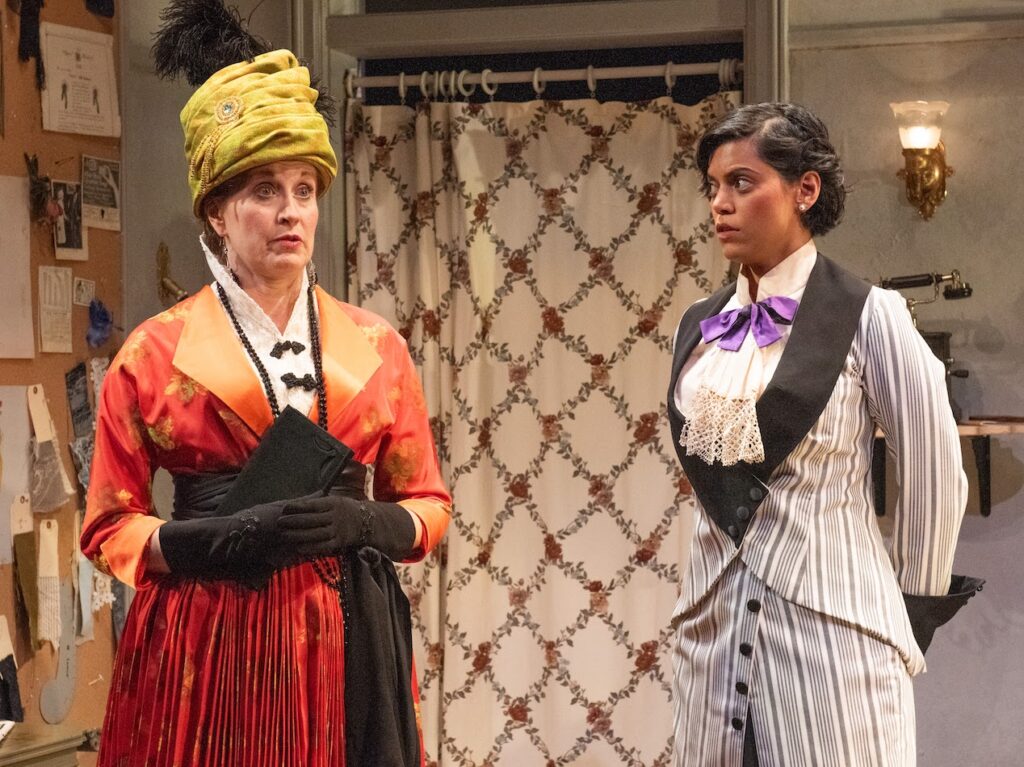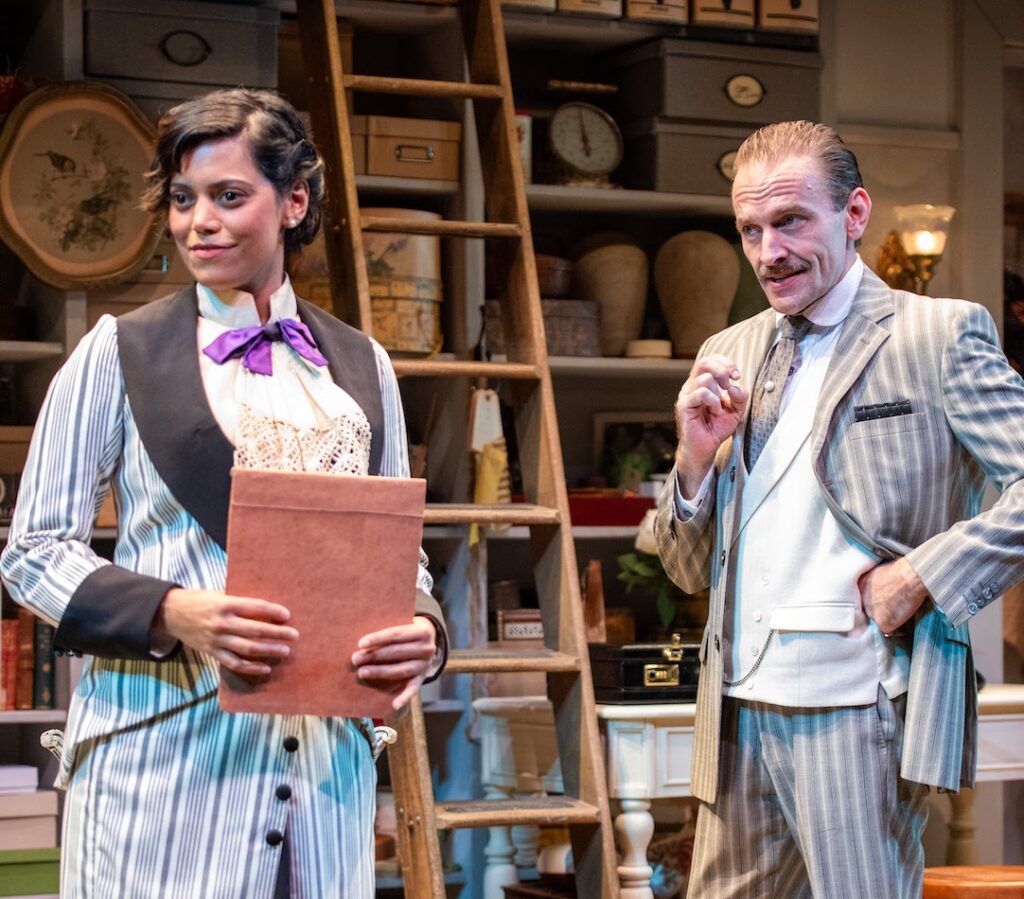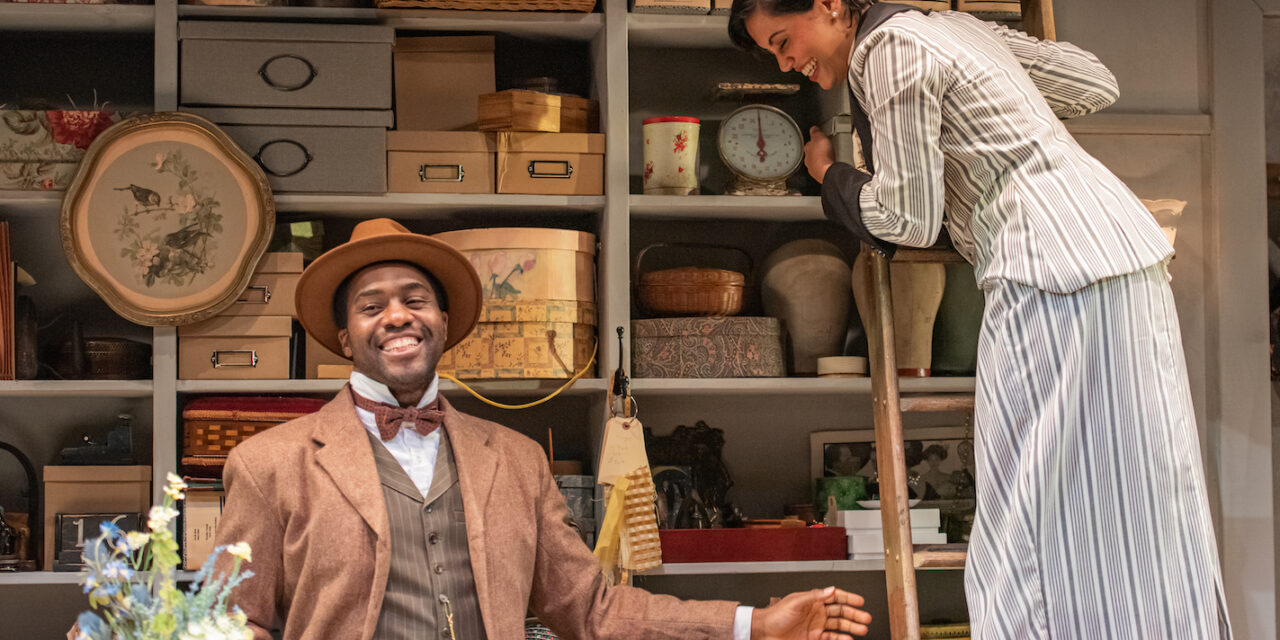By Samuel L. Leiter . . .
The Mint Theatre is widely lauded for reviving modern plays that, while long forgotten, appear to be worthy of another look. Often, the revivals uncover shiny treasures hidden in history’s trash heap of works that failed to catch on following their original productions; other times, the Mint’s productions prove that history made the right decision in the first place. Occasionally, artistic director Jonathan Bank has been so enamored of a hazily remembered playwright that he’s offered multiple works by them. British playwright Theresa Deevy (1894-1963), for example, has provided four plays, while another Brit, Elizabeth Baker (1876-1962), has been represented by three since 2019: The Price of Thomas Scott, Chains, and the one currently running at Theatre Row, Partnership. Of the three, Baker’s best known work, Chains (1909), is clearly the strongest, while Partnership (1917), is the weakest.
Partnership, a romantic comedy in the Shavian mode (George Bernard Shaw was a strong influence), brings Baker’s sharp sense of contemporary social issues to the world of English shopgirls, a world with which the author’s upbringing made her intimately familiar. The first and third of its acts are set in the dressmaking shop of couturier Kate Rolling (Sara Haider) in Brighton. Her employees are the childish clerk, Gladys Tracey (Madeline Seidman), engaged to the jealous Jack Webber (Tom Patterson); the opinionated but wise dressmaker Miss Blagg (Gina Daniels); and the flashily pretty, ambitious, and highly practical Maisie Glow (Olivia Gilliatt), Kate’s assistant designer, involved with a fellow named Elliman (also played by Patterson).

Apart from a snooty, upper-class customer, Lady Smith-Carr-Smith (Christiane Noll), who so admires Kate’s talent that she wouldn’t think of letting anyone else serve her, there are two principal men: the well-off but notoriously hardnosed businessman, George Pillatt (Gene Gillette), and his friend (loosely considered), Lawrence Fawcett (Joshua Echeberi). The latter’s a wealthy fellow who—to the surprise of everyone else—stepped away from his family’s highly successful corset business (the Esmerelda) to dabble in developing an orange-colored dye.
George wants to become Kate’s partner by buying the vacant but desirable shop next door, thereby expanding her business; he also wishes to marry her, not out of affection but as an arrangement that will somehow—it’s not quite clear how—benefit their partnership. Kate, whose business acumen the play is at lengths to emphasize, seems perfectly willing to accept such a loveless relationship; running a successful enterprise is her primary focus. Pillatt goes so far as to write up a prenuptial contract. What little tension the play has involves her decision to sign it.
The dramatic problem is that when Kate sees the exaggeratedly shy, retiring Fawcett, who appears in company with George in Act One, she finds him irresistibly interesting. Much of what follows deals with her falling in love with him (given what we see of him, God knows why) and rejecting George (given what we see of him, you don’t need God to explain why).


During the first act, the play seems a feminist exposition of women’s ability to successfully navigate the shoals of running a profitable business, even though it means experiencing occasional discomfort, such as making concessions to annoying customers like Mrs. Smith-Carr-Smith or handling the workplace love affairs of naïve young workers. In Act Two, however, Baker widens her scope to examine the difference between those who devote their lives entirely to their work, like Pillatt, and those who realize life must be a balance between work and pleasure, accent on the latter, which is Fawcett’s MO. In a sense, this is a debate between Nietzsche’s Apollonian and Dionysian views of life.
In a picnic scene set on the Downs, the hills overlooking the sea near Brighton, Kate is so entranced by Fawcett’s advocacy for freedom from the restraints of work (he’s wealthy, so he can talk!) and the opportunity to enjoy the fruits of nature that she even decides to walk with him the eight miles home rather than return with Pillatt by car. Of course, all is resolved, predictably, in Act Three.
The dialogue, spoken in British accents, is never particularly scintillating, nor, except for one or two decent laughs, notably funny. Rarely during the performance’s draggy two hours and 20 minutes (with two intermissions) do the stakes make us feel much pressure, a problem partly attributable to the uninspired direction of Jackson Grace Gay, who’s done far better work. The actors don’t help much either. Sara Haider fails to clearly express the conflict in Kate’s heart between which path to follow, appearing equally content with both the soulless Pillatt and the soulful Fawcett. Vocally strong and physically imposing, she performs as if good cheer were her motto, too frequently playing straight out to the audience rather than eye-to-eye with her fellows; as with most of them, one never senses an inner life, although Gina Gilliatt as Blagg and Olivia Gilliatt as Maisie acquit themselves nicely.


Joshua Echeberi’s Fawcett, supposedly insecure and bashful, comes off more as dull and charmless, even when he finds his voice in Act Two, but Gene Gillette’s Pillatt is a bigger problem, being played like a 19th-century villain, his slim figure dressed in dandified duds, a walking stick always at hand, and a sneeringly supercilious expression perpetually plastered upon his face. (Does anybody else notice his resemblance to Ralph Fiennes?) One waits for him to twirl his mustache and say, “Curses, foiled again!” How the seemingly rightminded Kate could possibly accept a partnership with such an obvious schemer beggars belief.
As usual, the Mint’s designers carry off their duties with relative aplomb. Alexander Woodward’s shallow shop setting, well lit by Mary Louise Geiger, captures the cramped space in which the women work. His scene on the Downs, however, is mainly a drop painting of the sea and surrounding hills as seen from the chalky hills, with an outcropping of rock at center. Oddly, as staged, the actors never look out at this gorgeous upstage landscape, but stare instead toward the audience, where the environment would likely be the less striking view of pastures.
Kindall Almond’s well-researched costumes are a major feature, providing vivid period clothing even under the constraints of what must have been a limited budget. Still, the women’s dresses seem a bit too long for 1917, when hems were rising above the ankles (there’s even a comical reference in the script to how short the new Parisian fashions are). And, among other questionable items, Kate’s major outfit, a striped one with faux tuxedo lapels set off by a violet bowtie, looks more deserving of the vaudeville stage than a dressmaker’s shop. The lack of wigs to suggest period hairdos is a drawback, but I guess there’s only so far you can stretch a budget.
And, speaking of stretching, I hope that the Mint’s infatuation with Miss Baker has reached its limit.
Partnership. Through November 12 at Theatre Row (410 West 42nd Street, between Ninth and Tenth Avenues). Two hours and 20 minutes with two intermissions. www.minttheater.org
Photos: Todd Cerveris Photography
Cover Photo: Joshua Echebiri and Sara Haider


















